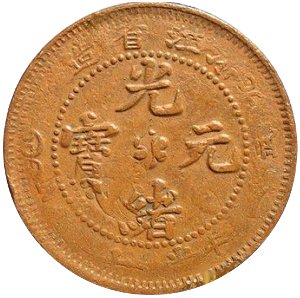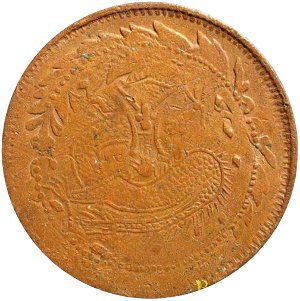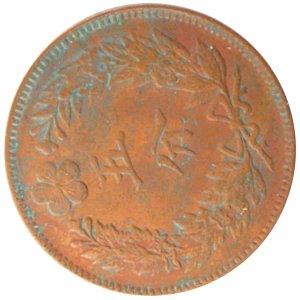China faced a severe shortage of small denomination coins at the end of the Qing Dynasty. To help alleviate the shortage, the Guangdong mint in the year 1900 began to produce a new style coin that was radically different from the hand-cast bronze “cash” coins with the square hole that had been used for more than 2,000 years.
The new coins were made of copper and did not have a hole in the center. Moreover, these coins were produced by machines.
The Chinese referred to the new coins as tong yuan (铜元) or tong ban (铜板) and they were minted in denominations of 1 Cash, 2 Cash, 5 Cash, 10 Cash, 20 Cash and 30 Cash.
The new style coins were immediately well-received by both the Chinese people and the merchants because they were uniformly well-made, of standard size and weight, and convenient to carry.
Because of the warm reception, more and more of the coins were minted. The coins were also profitable to make.
The mints in the other Chinese provinces quickly noticed the trend and within a short period of time there were 20 coin bureaus operating in 17 of China’s provinces producing the new copper coins. The tong yuan coins quickly replaced the traditional “cash” coins to become the major form of small denomination coins in circulation.
But anytime a new form of currency is introduced, counterfeit versions soon begin to appear. The 10 Cash (十文) coin in particular was a prime target for counterfeiters.
The first “counterfeiters” were actually the official mints themselves. The mints were given quotas to fill but because the coins reaped a good profit, the mints began to “privately” (局私) produce the coins in quantities which exceeded their official quotas.
Also, as has always been the case throughout China’s long history, individual Chinese began to illegally produce coins.
And as we shall see, foreigners became involved in counterfeiting the new coins as well.
Certain 10 Cash coins can be immediately identified as counterfeit because they tend to be poorly struck and especially because they show traces of inscriptions and symbols not found on the officially minted coins.

Chinese “10 Cash” coin overstruck on Korean “5 Fun” coin
An example of such a coin is shown at the left.
Upon close examination, it is obvious to Chinese coin collectors that the counterfeiters used a Korean “5 Fun” (五分) denomination coin as the blank to mint this Chinese “10 Cash” coin. The Chinese refer to these overstruck coins as han gai ban (韩改版).
Chinese numismatists have traditionally assumed it was certain Chinese mints that had used the Korean coins as planchets to make the 10 Cash coins. According to the theory, the Korean coins were used as planchets during the testing of the new coin presses.
A recent article by Ye Zhenming (叶真铭) in the Chinese periodical qianbi (钱币), however, provides a different explanation.
According to Mr. Ye, the overstruck coins were the result of collusion between Japanese “Ronins” (“wave men” 浪人) and some “unscrupulous” Korean merchants. A Ronin was a Japanese samurai who did not have a master and was therefore considered an outsider to society. Since it was difficult for Ronins to find legal employment, they sometimes turned to criminal activities.
The new coinage of China provided a lucrative opportunity for some of the Ronins.
These Ronins discovered that the Chinese mints were importing copper billet from Japan to make the new coins. The mints found that importing the copper billet was convenient and the price still allowed for a good profit margin.
The Ronins were able to obtain their own supply of Japanese copper billet. They had engravers forge coin dies based on the official mint dies and, using hand operated presses, began to counterfeit the new copper coins.
It was not long, however, before these Ronins discovered an even cheaper supply of copper blanks for the coins.
The Koreans began minting modern copper coins in 1892, eight years before the Chinese. These denomination “5 Fun” Korean coins were similar in size and weight to the new Chinese 10 Cash coins.
The Ronins realized that using the Korean coins as planchets for Chinese 10 cash coins could be very profitable.
This was due to the relative values of silver and copper. At the time, one Chinese silver dollar could buy more than 200 of the Korean copper coins.
But by overstriking the Korean coins to create Chinese 10 cash coins, the counterfeiters could then exchange ten of the coins for one silver dollar. The profit margin was thus very high.
The Ronins were able to partner with some unscrupulous Korean businessmen to obtain their supplies of Korean 5 Fun coins.

Reverse side of overstruck “10 Cash” coin
However, because the pressure from the hand-operated presses used by the counterfeiters was not sufficient to totally obliterate the inscription and symbols on the Korean 5 Fun coin, the counterfeit Chinese 10 Cash coins usually exhibit a combination of both the Chinese and Korean designs.
For example, at the left is the reverse side of an overstruck counterfeit coin. In the middle can be seen the dragon design found on Chinese 10 Cash coins.
You will also notice that there are traces of a wreath surrounding the dragon. The wreath is the remnant of the design from the Korean 5 Fun coin that served as the planchet to make the counterfeit coin.

Reverse side of Korean 5 Fun coin
The wreath can be clearly seen on the reverse side of the Korean 5 Fun coin shown at the left.
If you closely examine the obverse side of the coin (shown above), you will also notice that traces of the original Korean coin inscription are still present.
These counterfeit copper coins were mainly put into circulation in China’s coastal regions where they easily mixed in with the officially minted Chinese coins.
Most of the counterfeit dies used to make these coins state “made in Zhejiang Province” or “made in Shandong Province”. In reality, the coins could have been made anywhere but coins with inscriptions stating they were “made” in other provinces are fewer in number.
The true origin of these overstruck coins has puzzled Chinese numismatists for years. The traditional explanation has been that they were created during testing of the new presses by the Chinese mints.
This new explanation is consistent with the economic situation that existed at the time. It also introduces a degree of foreign intrigue with the involvement of Japanese samurai and Korean businessmen.
Gary,
Great research. Thanks much for the information – it also tells an interesting story.
i have purchased cash coins from Ebay that turned out to be about 40 mm when they arrived. Can you direct me to any information as to what the denomination would have been? are they contemporary fakes? I have been searching for information on the size of cash coins at different time periods.
Hi Karen,
Please provide clear images of the coins and I will try to identify them for you.
My email address can be found at the bottom of this page.
Gary
Very great information.
So what type of values do the contemporary counterfeits retain?
Do you believe any of these coins were struck by an official Chinese mint? I have one that is well struck. Thank you.